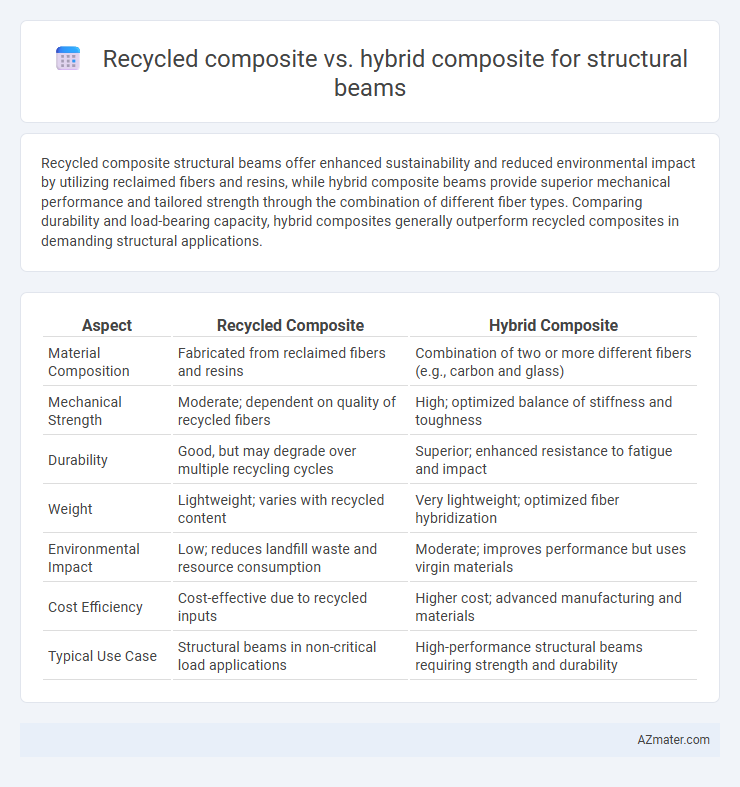Recycled composite structural beams offer enhanced sustainability and reduced environmental impact by utilizing reclaimed fibers and resins, while hybrid composite beams provide superior mechanical performance and tailored strength through the combination of different fiber types. Comparing durability and load-bearing capacity, hybrid composites generally outperform recycled composites in demanding structural applications.
Table of Comparison
| Aspect | Recycled Composite | Hybrid Composite |
|---|---|---|
| Material Composition | Fabricated from reclaimed fibers and resins | Combination of two or more different fibers (e.g., carbon and glass) |
| Mechanical Strength | Moderate; dependent on quality of recycled fibers | High; optimized balance of stiffness and toughness |
| Durability | Good, but may degrade over multiple recycling cycles | Superior; enhanced resistance to fatigue and impact |
| Weight | Lightweight; varies with recycled content | Very lightweight; optimized fiber hybridization |
| Environmental Impact | Low; reduces landfill waste and resource consumption | Moderate; improves performance but uses virgin materials |
| Cost Efficiency | Cost-effective due to recycled inputs | Higher cost; advanced manufacturing and materials |
| Typical Use Case | Structural beams in non-critical load applications | High-performance structural beams requiring strength and durability |
Introduction to Structural Beam Materials
Recycled composite materials for structural beams utilize reclaimed fibers and resins, offering sustainable solutions with reduced environmental impact and competitive strength-to-weight ratios. Hybrid composites combine two or more fiber types, such as carbon and glass fibers, to optimize mechanical properties including stiffness, strength, and durability in load-bearing applications. Selection between recycled and hybrid composites depends on performance requirements, cost considerations, and sustainability goals in structural engineering projects.
Overview of Recycled Composites
Recycled composites for structural beams utilize reclaimed fibers and resin matrices, reducing environmental impact while maintaining competitive mechanical properties such as tensile strength and stiffness. These materials often consist of processed waste from carbon or glass fiber composites, enhancing sustainability in construction applications. The recycling process can influence fiber orientation and bonding quality, affecting load-bearing capacity and durability compared to virgin or hybrid composites.
Understanding Hybrid Composites
Hybrid composites combine two or more distinct fiber types, such as carbon and glass fibers, to optimize mechanical properties like strength, stiffness, and impact resistance in structural beams. Recycled composites, typically made from reclaimed fibers and resin, offer environmental benefits but often exhibit lower performance due to fiber degradation and inconsistent quality. Understanding hybrid composites allows engineers to design beams with tailored properties that meet specific load and durability requirements while balancing cost and sustainability considerations.
Material Properties Comparison
Recycled composites exhibit enhanced sustainability with moderate tensile strength and stiffness, making them suitable for non-critical structural beam applications, whereas hybrid composites offer superior mechanical properties including higher flexural strength, impact resistance, and fatigue durability due to the combination of multiple reinforcing fibers such as carbon and glass. The density of recycled composites is generally lower, contributing to lightweight design but often sacrificing long-term structural performance compared to hybrid composites, which optimize load-bearing capacity through synergistic reinforcement. Thermal stability and moisture resistance are significantly better in hybrid composites, improving service life in harsh environments compared to recycled composites that may absorb more moisture and degrade faster under thermal cycling.
Environmental Impact Assessment
Recycled composite beams reduce landfill waste by utilizing post-consumer materials, significantly lowering carbon emissions compared to virgin composite production. Hybrid composites combine natural fibers with synthetic resins, offering enhanced biodegradability and reduced energy consumption during manufacturing while maintaining structural performance. Environmental impact assessments highlight that recycled composites favor circular economy goals, whereas hybrid composites optimize the balance between durability and ecological footprint in structural applications.
Cost Analysis: Recycled vs Hybrid
Recycled composite structural beams typically offer a lower material cost compared to hybrid composites due to the use of waste fibers and resins, reducing raw material expenses. Hybrid composites, combining traditional fibers like carbon or glass with recycled materials, generally incur higher production and processing costs, reflected in increased overall investment for structural applications. Long-term cost efficiency also depends on performance factors such as durability, maintenance requirements, and lifecycle analysis, where hybrid composites may justify higher initial costs through enhanced structural strength and longevity.
Performance in Structural Applications
Recycled composites for structural beams offer sustainable performance with moderate strength and durability, making them suitable for non-critical load-bearing applications. Hybrid composites combine different fiber reinforcements, such as carbon and glass fibers, resulting in enhanced mechanical properties like higher stiffness, strength, and impact resistance ideal for demanding structural uses. Hybrid composites outperform recycled composites in load capacity and long-term structural integrity, making them preferable for critical beam applications requiring superior performance.
Durability and Lifespan Considerations
Recycled composites for structural beams offer environmental benefits but may exhibit reduced durability and lifespan compared to hybrid composites, which blend natural and synthetic fibers to enhance mechanical strength and resistance to fatigue. Hybrid composites typically demonstrate improved resistance to moisture, UV degradation, and mechanical wear, resulting in longer service life under varying environmental conditions. Selecting the optimal composite material depends on balancing sustainability goals with structural performance requirements and expected maintenance cycles.
Challenges and Limitations
Recycled composites for structural beams face challenges such as reduced mechanical strength and durability due to fiber degradation during recycling processes. Hybrid composites often encounter limitations in achieving optimal interfacial bonding between different material phases, which can compromise load transfer and overall structural integrity. Both materials require advanced manufacturing techniques and rigorous quality control to address inconsistencies and ensure long-term performance in structural applications.
Future Trends in Composite Structural Beams
Recycled composites in structural beams are gaining traction due to sustainability and circular economy goals, utilizing waste materials to reduce environmental impact without compromising strength. Hybrid composites, combining different fiber types like carbon and glass, enhance mechanical performance and durability, driving innovation in load-bearing efficiency. Future trends emphasize optimizing these materials for lightweight, high-strength applications through advanced manufacturing techniques and smart design integration.

Infographic: Recycled composite vs Hybrid composite for Structural beam
 azmater.com
azmater.com